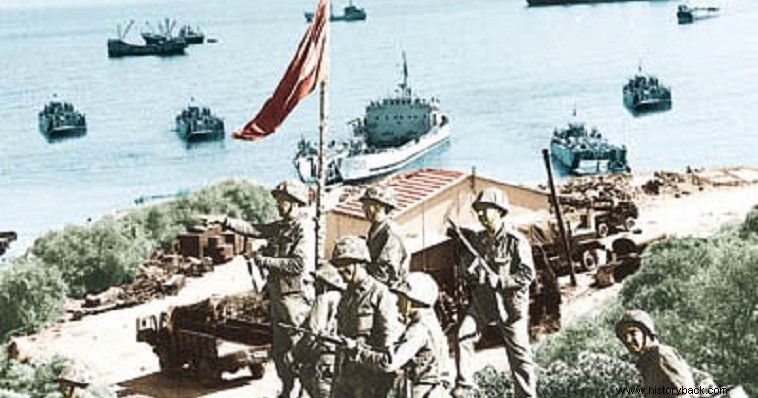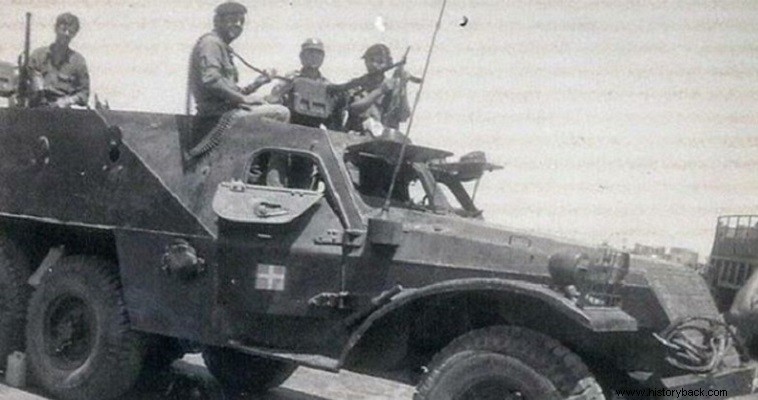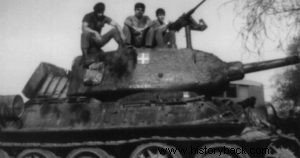
The decision of the Turks to invade Cyprus was made long before the coup against Makarios. The Turks, with their well-known oriental cunning, were simply waiting for the right conditions.
The Turks knew the Greek weaknesses firsthand and exploited them to the fullest. For the occupation of Cyprus, to which they gave the prophetic code name "Attila", the Turks assembled the following forces:
1) The headquarters of the 6th Army Corps, under Lieutenant General Nuredin Eskin, based in Adana.
2) The 39th Infantry Division (MP) with the 14th, 49th, 50th Infantry Regiments (SP), in Mersina (Lieutenant General Betretin Demirel).
3) On the 28th MP with the 23rd, 61st, 13th SP.
4) The Parachute Brigade in Caesarea (with 2 paratrooper battalions and an infantry battalion).
5) The 39th Commando Brigade with two commando squadrons.
6) The 5th Armored Brigade.
7) The 6th Marine Battalion (MPN)
The invasion would be supported by serious air forces, whose mission would initially be to ensure air superiority and then to provide close support to the ground units. It seems that the Turks, on the contrary, along with some Greek military and politicians, believed that Cyprus was not that far from Greece and could be supported by the Greek air force.
As the first echelon of the assault, the landing troops were made up of the 5th SP, the 6th TPN and a tank company, under Brigadier Suleiman Toursel. This echelon was called the "Cakmak" Brigade and had a strength of 3,500 men. In total, the Turks threw into battle 40,000 men, 180-200 M47-M48 tanks.
They were supported by 75 fighter and 55 transport aircraft, 43 helicopters and several naval units. To these forces must be added the forces of TURDYK and the Turkish Cypriots, a total strength of about 20,000 men.
It is worth noting that the Turkish Cypriot "militia" had been operating undisturbed for years before the invasion and had turned the Turkish Cypriot enclaves on the island into impregnable fortresses, which even had machine guns made of reinforced concrete! In particular, the Nicosia enclave (Nicosia-Kioneli-Agyrta-Ag. Hilarion up to the village of Templos) had concrete fortifications, a corridor to Agyrta and placed under Turkish control the most important crossing of Ag. Hilarion. TURDYK with 1,200 men was stationed at Kioneli.
On the other hand, the Greek forces were as follows:
– The headquarters of the General Staff of the National Guard (GEEF), under Brigadier General Michael Georgitsis
1) 15 active infantry battalions, but extremely reduced in strength, due to the reduction of the mandate that the Makarios government had proceeded with on the eve of the coup.
2) 19 enlisted infantry battalions, of which few were formed.
3) The ELDYK with a strength of about 900 men
4) Three active squadrons and one enlisted raiding squadron.
5) A tank battalion equipped with 15 T34/85 tanks, remnants of World War II.
6) A reconnaissance detachment with light armored vehicles also of the 2nd PF.
7) 8 artillery companies and 4 independent artillery companies of various calibers and 1 company of 4.2-inch mortars.
8) Small number of engineering, transmission and administrative units.
There was no air force and, based on the existing plans, the coverage of the land sections would be undertaken by the Greek Air Force. As for the naval forces, they were limited to 5 torpedo boats and one cruiser. The total strength of the Greek forces did not exceed 11,000 enlisted men.
From the list of forces it is clear that once the Turks would achieve a bridgehead on the island, the situation would develop unfavorably for the Greek forces since the enemy was overwhelmingly outnumbered (about 6:1 in infantry and 18:1 in tanks) and in material quality.
However, the existence of thousands of armed Turks and Turkish Cypriots already on the island, before the invasion, preemptively prevented the GEEF's ability to achieve a strategic concentration. Quite simply, the Greek forces were not sufficient to guard the landing beaches and neutralize the fortified Turkish Cypriot enclaves.
In the event of an invasion, the Cypriot defense had to be immediately reinforced with Greek units. Otherwise, everyone knew that, sooner or later, it would collapse. Thanks to the heroism of the Greek fighters, it finally collapsed later than expected. Also, always based on the planned plans, any attempted landing of the Turks in Cyprus would signal the immediate outbreak of Greek-Turkish war. With this as a given, the Turks would be obliged to commit the overwhelming bulk of their forces to Thrace and the Asia Minor coast.
Thus, the Cypriot defense would be relieved. Also, two more facts weighed in favor of the Greek side. The absolute superiority of the Greek Navy and Air Force, compared to the corresponding Turkish ones.
In practice, however, this superiority remained on paper. The same was done with the planned Greek counterattack in Thrace, which would in all probability be completely successful, at least as far as Adrianople. The order to attack, however, never reached the armored Greek units stationed on the Evros, with a manning rate of 110% or more, despite the myths that were cultivated afterwards. There were weapons, there was no will.
The island of Cyprus is crossed by two parallel mountain ranges running west to east, Olympus (or Troodos) in the central-west with the highest peak Troodos (1,952 m.) and Pentadaktylos in the north with the highest peak Kyparissovouno (1,023 m.). Both mountain ranges are wooded, rugged and constitute anti-tank terrain. Between them, the plains of Morphou, Mesaoria and Famagusta are formed, with the larger one of Mesaoria, where the capital Nicosia is also located.
Between the northern coasts of Cyprus and Troodos is formed the narrow lowland strip of the province of Kyrenia, with the city of the same name as its capital. This lane communicates with Mesaoria only through the Pentadaktylos crossings. The main crossing is that of Agios Hilarion, through which the main Kyrenia-Nicosia road passes.
Other important crossings are, of Panagra in the west, of Ag. Pavlos, of Bela Pais et al., on Pentadaktylos. The coasts of Cyprus, stretching 342 km, form several bays and offer many beaches. The most notable are in the cities of Famagusta, Larnaca and Kyrenia Limassol.
The Turkish plan of operations provided for combined amphibious and airborne power to divide Cyprus in two phases, taking full advantage of the morphology of the Cypriot terrain. During the first phase, a landing would be carried out on the coast of Pendemili west of Kyrenia in order to create a bridgehead with a simultaneous air landing in the enclave of Nicosia to reinforce the Turkish Cypriots and TURDYK.
Subsequently, the gradual expansion of the pre-bridge and its connection with the Nicosia enclave was foreseen. During the second phase, and depending on the development of the first phase, operations to achieve Turkey's political goals would continue. The first phase would be combined with the deceptive action against Famagusta. The two phases were codenamed "Attila" I and II respectively.
The GEEF Defense Plan, with the code name "Venus", envisaged securing Cyprus from a Turkish threat, with the main effort being to repel the landing and the secondary, the liquidation of the Turkish enclaves. A political decision was required for the time to clear the enclaves, while the decision to repel the landing force was the responsibility of the head of the EOEF, as soon as the territorial waters of Cyprus were violated (12 nautical miles). ELDYK was planned to be made available to GEEF, as well as a number of warplanes and ships of the Greek Armed Forces.
Invasion
On Saturday 20 July, at 04.50, 11 warships violated the territorial waters of Cyprus and stopped their movement 10-11 km from the coast of Kyrenia. From 05.15 the Turkish Air Force began heavy bombing of military and political targets mainly in the Kyrenia-Nicosia area. At 06.00, the dropping of paratroopers began to reinforce the Nicosia enclave (Kioneli).
At the same time, Turkish commandos were being transported to Ayurta by helicopters, which, according to some sources, were refueled to the British aircraft carrier "Mercury", which, completely "coincidentally", was patrolling off Cyprus that morning.>
Turkish airstrikes continued throughout the day. On the chosen landing coast, in Pendemili, before 06.00 a check was made by Turkish frogmen for the existence of sea obstacles and minefields.
After ascertaining that there were no obstacles on the bottom and shore, they returned. A few minutes later, heavy fire started from the Turkish warships and at 07.15 the 6th TPN began to disembark creating a small bridgehead. At 09.00 airborne units reinforced the small bridgehead and cut off the Kyrenias-Panagron road.
The first reaction against the Turks was marked by the heroic Cypriot torpedo boats, which sacrificed themselves trying in vain to hit the Turkish warships. The GEEF only at 07.00 put its forces on alert, although it already had information about the approach of the Turkish convoy, alerted by the observation stations of Ag. Andreas and Kormakitis.
The head of the Armed Forces of Greece, General Bonanos, had cultivated the impression that the Turks were merely making a show of force. Later there was also talk of a Turkish exercise. After all, he is also responsible for the withdrawal from Cypriot waters of the then state-of-the-art submarines "Glafkos" and "Nireus", as well as for not sending the F-4 Phantom aircraft stationed in Crete, which at that time were the most advanced existed in the eastern Mediterranean. However, the example of Bonanu was followed by the subsequent civil government.
Bonanus only realized what was happening at 08.40 – when it was too late – and ordered the plans to be implemented. At 10.00 – almost 3 hours after the invasion – two reduced companies of the 251st Infantry Battalion (IP), reinforced by 4 tanks, surrounded the bridgehead from the east and south and at 10.00 began a barrage of fire, which turned into hell the coast. The widening of the bridgehead stopped, and its reinforcement was now under heavy fire from the few defenders.
The Greek artillery fire on the other hand was sporadic and misguided, due to the lack of advanced observation officers in the 251 TP. The Battalion, according to the plans, was to be immediately reinforced by the conscripted 3rd Tactical Group (306 and 316 conscripted infantry battalions). In these critical hours, the 3rd Tactical Group did not manage to reinforce the fighting 215 TP, because the formation of 306 and 316 was not achieved.
At 13.00, a convoy of the deployed 316 TP made contact with the Turkish bridgehead from the west. The GEF - which did not have accurate information about the situation - moved at first light the 286 Motorized Infantry Battalion (MIB) and the 281 TP, from the Nicosia area, to reinforce the fight in Pendemili.
In the morning hours, at the height of Kontemenos, the battalions received successive attacks by the Air Force, as a result of which they were decimated. The GEEF, with the remnants of these units and with their men's morale shattered (the commander of 286 MKTP had been mortally wounded), frantically planned a counter-attack on the night of 20/21, without rudimentary preparation and without supporting fire, a counter-attack that was doomed in complete failure. ELDYK, which could be used against the bridgehead, undertook the mission to clear, without support, the enclave of Kionelli.
Naturally, he failed against the overwhelming numerical superiority of the Turks. Thus, even the few forces that the GEEF had were wasted in uncoordinated attacks, beyond any application of the principle of concentration of forces. The same fate had the attack of the raiding units at the crossing of Ag. Hilarion. The actions of the ELDYK and commandos were doomed, because, apart from the far superior forces of the Turkish Cypriots, the enclave of Nicosia had already been reinforced with strong forces of paratroopers and commandos.
By nightfall, the Turks had succeeded in reinforcing the bridgehead with the entirety of the 5th Infantry Division. Until then, however, they had not managed to land any tanks. It was the golden opportunity of the Greeks to drown them in the sea. Unfortunately at that moment around the bridgehead there were effectively forces equivalent to 4 infantry companies, and these not complete, against three Turkish battalions.
Nevertheless, the day could be characterized as a good one, since the Turks failed in all their objectives, which were the capture of Kyrenia and the joining of the bridgehead with the enclave of Nicosia. After last light, the Turks stopped acting.
Again Turkish inactivity gave the Greek command a wonderful opportunity to wipe out the Turkish bridgehead that night, as the Turks could not be supported even by their air force. Again, however, it was not possible to gather the necessary forces in the critical area of Pendemilion.
At dawn the next day, the Turkish bridgehead was reinforced with new infantry forces and a swarm of tanks, against which the defenders had little to oppose, apart from their Greek souls. The Turks, with a hard fight, widened the bridgehead, now supported by dozens of their aircraft. Despite all this, they did not manage to break through the Greek defensive perimeter and move towards Nicosia. The reinforcement of the Greek forces with a procession of the recruited 326 TP also contributed to this.
In the Turkish enclave of Nicosia, reinforcements with paratroopers and commandos continued to arrive unceasingly. The enclave thus acquired offensive capabilities. The Turks, even during the operations of the second day, did not succeed in advancing towards Kyrenia-Ag. Hilarion. This worried them greatly. On that day, the comic-tragic event of the attack on three Turkish destroyers by the Turkish Air Force was also recorded!
The Turkish aircraft managed to sink the destroyer "Kotzatepe" and seriously damage the other two. For its part, the Turkish Navy could be proud of shooting down 5 Turkish fighters! This incident alone is capable of showing what kind of opponent we faced.
By the next morning the bridgehead had been widened enough to allow the entire Turkish 39th MP to land. Its commander, Major General Betretin Demirel, formed a fast-moving tactical group with special forces, tanks and powerful artillery and attacked towards Kyrenia.
The Turks were in a hurry to unite with the enclave of Nicosia until 16.00 on the day when the UN-decided cease-fire began. At about 11.00 the epic resistance of 251 TP was overcome. Since then, its hero commander, lieutenant colonel Pavlos Kouroupis, remains missing. The Turks then occupied Kyrenia and the passage of Ag. Hilarion. The same night, the northern districts of Nicosia, Neapoli, Omorfita, Kaimakli were occupied.
In the hours after midnight, the 1st Assault Squadron (Operation "Victory") landed in Nicosia and strengthened the defense of the Cypriot capital. A ceasefire was reached – in theory – that night. The Turks, violating, as always, the agreements they had signed a few hours ago, continued the operations.
In the first phase, they landed all the forces of the 6th Army Corps in Cyprus and then, based on the enclave of Nicosia, they attacked with the aim of capturing the city. At 11.00 on 23 July with strong infantry forces, reinforced by numerous tanks, they attacked the Nicosia airport. They were repulsed thanks to the heroic resistance of the 1st Commando Squadron. Six hours later the airport was handed over to the UN blue-collar workers.
But the Turks did not stop there. Between July 23-30 they occupied Ano and Kato Dikomos, Syhari, Vounos, Ag. Epiktito, Gerolakos, Myrtou Agridaki, Ag. Ermolao and the crossings of Pentadaktylos Syhari and Ag. Pavlos, on August 6 and 7 the villages of Karavas and Lapithos.
According to Brigadier General E.A. Δημήτριο Χάντζο, διοικητή του 361 ΤΠ τότε οι μονάδες των κυανόκρανων, ειδικά οι βρετανικές, βοήθησαν ποικιλοτρόπως τους Τούρκους στην επίτευξη των αντικειμενικών τους σκοπών. Ακόμα και υπό αυτές τις συνθήκες πάντως οι Τούρκοι δεν είχαν κατορθώσει να καταλάβουν παρά το 11% περίπου του κυπριακού εδάφους.
Στο μεταξύ στην Ελλάδα σημειώνονταν ραγδαίες πολιτικές εξελίξεις. Οι στρατιωτικοί κάλεσαν τον αυτοεξόριστο στη Γαλλία Κωνσταντίνο Καραμανλή να επανέλθει στη χώρα και να σχηματίσει κυβέρνηση. Η νέα ελληνική κυβέρνηση επίσης δεν έπραξε το παραμικρό για να ενισχύσει την αγωνιζόμενη Κύπρο. Περιορίστηκε να συμμετάσχει στις ειρηνευτικές συνομιλίες στη Γενεύη. Οι Τούρκοι συμμετείχαν στις συνομιλίες, αποδεχόμενοι και πάλι θεωρητικά, την νέα κατάπαυση πυρός. Το πόση αξία είχε βέβαια η υπογραφή των Τούρκων καταδείχθηκε λίγες ημέρες μετά.

Όχημα ΒΤΡ-152 του 286 ΜΚΤΠ

Άρμα μάχης T-34/85 του Β΄Παγκοσμίου Πολέμου της Εθνικής Φρουράς.
